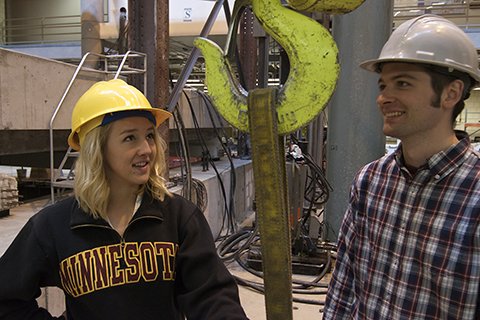Department of Civil, Environmental, and Geo- Engineering
Programs in civil, environmental, and geoengineering focus on designing sustainable infrastructure systems and developing environmentally responsible use of earth resources. Faculty are internationally recognized for research in landscape vulnerability assessment, wind energy, stream restoration, structural response to extreme loading, water treatment, environmental remediation, seismic imaging and material characterization, traffic control and safety, and hydraulic fracturing.
Tradition of excellence
The department dates back to more than a century. Minnesota's first wastewater treatment plant was designed by a faculty member. Alumni include founders of major engineering firms, the first female engineer in the Wisconsin Highway Commission, a pioneer in industrial pollution control, and leaders in the U.S. Army Corps of Engineers and Transportation Research Board.
World-class academics
Students study sustainable water supplies, structural monitoring, stormwater runoff treatment, and public health. The civil engineering program focuses its core courses on environmental, geomechanics, structures, transportation, and water resources. Students can put their ideas into action through undergraduate research and by participating in social entrepreneurship through the Acara Challenge.
The department also offers an integrated degree program, which allow students to complete both a bachelor's and master's degree in 5 years.
The Bachelor of Civil Engineering (B.C.E.), Bachelor of Environmental Engineering (B.EnvE.), and Bachelor of Geoengineering (B.GeoE.) are accredited by the Engineering Accreditation Commission of ABET.
Cutting-edge research
Research focuses on managing and sustaining water and land-use infrastructure, mitigating disaster of natural and built environments, engineering and developing earth resources, and designing renewable energy systems. The department is home to the Multi-Axial Subassemblage Testing (MAST) Laboratory, a structural system that allows researchers to test the effects of earthquakes, high winds, and other extreme forces. Several faculty members are affiliated with the St. Anthony Falls Laboratory.
The National Center for Earth-Surface Dynamics brings together researchers to study how erosion, sediment movement, and other forces shape the planet’s surface. The department houses the Minnesota Traffic Observatory, where researchers analyze local Twin Cities traffic.
Business and industry connections
Faculty have connections and collaborations with Minnesota businesses and companies worldwide. They also partner with government agencies, consulting firms, technical associations, and other universities.
National rankings
- Civil engineering consistently ranks among the top 20 programs nationwide.
- The geoengineering program is well-regarded, both nationally and internationally.

